5.4 Respiratory System Medications
Respiratory system medications are often given to alleviate allergies or cold symptoms, or to decrease or eliminate shortness of breath (SOB). These medications are available in many different formulations, including nasal sprays, inhalations, oral tablets and liquids, injections, and intravenous. It is always important to ensure that medications are given as ordered. For example, inhalations deliver the required medicine(s) directly to the lungs, which means the medication can act directly on the lung tissues, minimizing systemic side effects. On the other hand, intravenous medications act quickly but can cause systemic side effects. Additionally, some products contain more than one medicine with different dosages; for example, inhalers that combine a long-acting bronchodilator with a corticosteroid. This section will review several respiratory medication categories, common medications in each category, and key concepts related to respiratory medications.
Bronchodilator Medications
Bronchodilator medications are used to treat many pathologies, including asthma, COPD, and bronchitis. The goal of therapy is to relax the muscles around the bronchioles, which in turn helps them dilate and improves airflow to the lungs. In addition to improving airflow, the dilation of the bronchioles makes it easier to cough up excess mucus that is produced in some of these pathologies (Cleveland Clinic, 2022). Short-acting bronchodilators are used for acute asthma attacks and last three to six hours; they are often referred to as “rescue inhalers.” Long-acting bronchodilators are generally used to prevent asthma attacks and can last for up to 12 hours. The different types of bronchodilators are discussed below.
Beta-2 Agonist Bronchodilator Medications
Bronchodilators in this category stimulate beta-2 adrenergic receptors in the smooth muscle of the bronchi and bronchioles, producing bronchodilation. Beta-2 agonist bronchodilators come in both short-acting and long-acting medication forms. Short-acting albuterol (Ventolin) is used to prevent or treat bronchospasms in people with asthma or exercise-induced bronchospasm. Long-acting salmeterol (Serevent) is used to prevent bronchospasm.
Fig. 5.10 is an image and description of albuterol (Ventolin), a short-acting beta-2 agonist bronchodilator. It and many other respiratory medications are delivered using a metered-dose inhaler (MDI). To use an MDI, you have to press down on the canister to release the medication, which is then inhaled into the lungs. The dosage is measured in puffs or actuations.
An alternative device that can be used to assist with the delivery of respiratory medications such as albuterol is called a nebulizer. The medication comes in a small nebule that contains a liquid form of the medication (Fig. 5.12). The medication is then placed into a small medicine cup that sits under the facemask that is worn during administration of the medication. The nebulizer machine is then turned on, and the medication is turned into a mist that flows up into the mask and is inhaled into the lungs by the patient. An image of a patient demonstrating the use of a nebulizer is shown in Fig. 5.11.
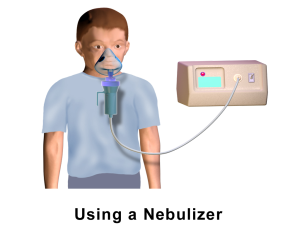
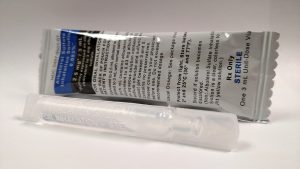
Common medications in this category include the following:
- albuterol (Ventolin) – short acting
- salmeterol (Serevent) – long acting
Sometimes patients have a difficult time using an inhaler properly, which can result in them not getting the entire dose of the medication. In this situation, they may need to use a device called a spacer. A spacer is a long, plastic chamber that holds the dose, as shown in Fig. 5.13, while the patient continues to take several breaths to inhale the medication. It is often used with pediatric and geriatric patients.

The following video provides an overview of how to properly use a spacer.
(AbrahamThePharmacist, 2018)
Key Concept
A common suffix seen with generic beta-2 agonist bronchodilator medications is -terol.
Examples: albuterol (Ventolin), salmeterol (Serevent)
Anticholinergic Bronchodilator Medications
Anticholinergics block the action of acetylcholine in the bronchial smooth muscle, which reduces bronchoconstrictive substance release. This causes the bronchioles to relax and dilate. This medication category includes both short-acting and long-acting anticholinergic drugs. Ipratropium (Atrovent) is an example of a short-acting anticholinergic bronchodilator, and tiotropium (Spiriva) is an example of a long-acting anticholinergic bronchodilator. Anticholinergics are used for maintenance therapy of bronchoconstriction associated with asthma, chronic bronchitis, and emphysema.
Tiotropium (Spiriva) is slightly different than other inhaled medications because it is delivered with a device called a HandiHaler. This inhaler does not use canisters like other inhaler devices, but instead uses capsules that are inserted into a slot inside the inhaler. The patient then closes the lid and compresses the button on the side on the inhaler, which pierces the capsule and releases the powder inside, as shown in Fig. 5.14 and Fig. 5.15. The patient then uses the mouthpiece to inhale the medication.
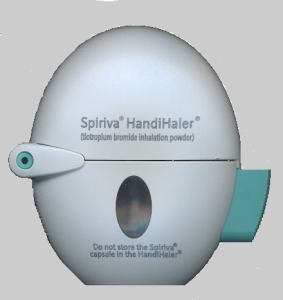

Key Concept
A common suffix seen with generic anticholinergic bronchodilator medications is -tropium.
Examples: ipratropium (Atrovent), tiotropium (Spiriva)
Corticosteroid Medications
Corticosteroids are medications similar to the hormones produced in our own bodies. They work by preventing the release of substances that cause inflammation; however, they also suppress the immune system. Corticosteroids are not used to treat an acute asthma attack but rather help prevent an asthma attack. They can be prescribed in a variety of routes. Fluticasone (Flovent) is an example of a commonly used inhaled corticosteroid, prednisone is an example of a commonly used oral corticosteroid, and methylprednisolone is a commonly used IV corticosteroid. The focus in this section will be on medications that are inhaled into the lungs and are administered using an inhaler device.
The following corticosteroid medications are used in the management of common respiratory pathologies such as asthma:
- fluticasone (Flovent) (Fig. 5.16)
- budesonide (Pulmicort) (Fig. 5.17)
- ciclesonide (Alvesco)
- mometasone (Asmanex)
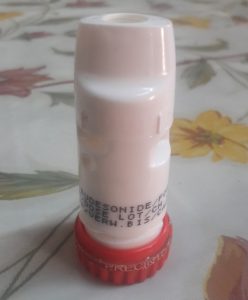
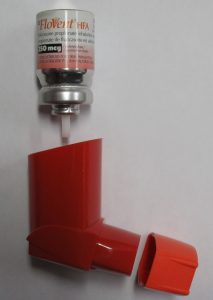
Budesonide (Pulmicort) is delivered using a inhaler device called a Turbuhaler. The powdered corticosteroid is inside the inhaler device, and in order to get a dose (puff), you have to twist open the cap (the red part in Fig. 5.17) to prepare the dose. Then you place your mouth on the mouthpiece and inhale the medication into your lungs. The Turbuhaler has a dose counter on the device and usually contains 60 to 120 doses.
Key Concept
Common suffixes seen with generic corticosteroid medications are -sone, -sonide, and -metasone.
Examples: fluticasone (Flovent), budesonide (Pulmicort), mometasone (Asmanex)
Xanthine Derivative Medications
Xanthine derivative medications work by relaxing the bronchial smooth muscle by inhibiting the enzyme phosphodiesterase and suppressing airway responsiveness to stimuli that cause bronchoconstriction. They are used for long-term management of asthma that is unresponsive to beta agonists or inhaled corticosteroids. They are also used for long-term treatment of COPD that is unresponsive to other treatment. Theophylline (Elixophyllin) is an example of a xanthine derivative, with the common suffix -phylline, and is taken orally in tablet form.
Combination Medications
Inhalers can combine two medications; for example, the brand-name medication Combivent is a combination of a beta-2 agonist bronchodilator medication (albuterol) with an anticholinergic bronchodilator medication (ipratropium) (WebMD, 2023d). It is most often used to treat symptoms related to COPD (WebMD, 2023d). Another common combination inhaler on the market is Advair, which combines the corticosteroid medication fluticasone with the beta-2 antagonist bronchodilator salmeterol (WebMD, 2023a). This inhaler is often used to treat asthma, COPD, bronchitis, and emphysema. Advair comes in an inhaler called a Diskus device, which is shown in Fig. 5.18 (WebMD, 2023a).
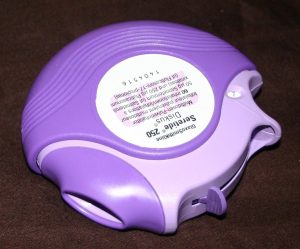
The following video shows how to use the various types of inhaler devices that have been discussed on this page.
(SingHealth, 2011)
Leukotriene Receptor Antagonist Medications
Leukotriene is a chemical in the body that is produced when a person comes into contact with allergens that cause symptoms such as sneezing, running eyes, congestion, and airway constriction (WebMD, 2021). Leukotriene receptor antagonists work by blocking the actions of leukotriene and decreasing inflammation. The most common medication in this category is montelukast (Singulair), shown in Fig. 5.19. The medication is safe for children 12 months of age and older, and is available in granule packets and chewable tablets, as well as regular tablets. Montelukast is used for long-term control of asthma and for decreasing the frequency of asthma attacks. It is also indicated for exercise-induced bronchospasm and allergic rhinitis. Patients should take the medication at the same time every day and at least two hours prior to exercise.
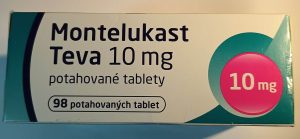
Antihistamines
Antihistamines work by blocking histamine at H1 receptors, which then inhibits smooth muscle constriction and decreases capillary permeability, salivation, and tear formation. Antihistamines are used for the relief of allergy or cold symptoms. They may cause drowsiness, and concurrent use of alcohol or other CNS depressants should be avoided. Medications in this category are available in various routes, including orally, topically (eye drops), and intravenously. Diphenhydramine (Benadryl) is a commonly prescribed antihistamine and is shown in Fig. 5.20
The following is a list of common antihistamines:

- diphenhydramine (Benadryl)
- cetirizine (Zyrtec)
- fexofenadine (Allegra)
- loratadine (Claritin)
- ketotifen (Zaditor) – eye drops
(WebMD, 2023b)
Expectorant Medications
Expectorants are used for a productive cough and loosen mucus in the respiratory tract. They reduce the viscosity of secretions, which helps loosen sputum (mucus) and thin bronchial secretions to make coughs more productive. A common example of an expectorant medication is guaifenesin (Mucinex). Guaifenesin is taken orally in tablet, powder, or liquid form (WebMD, 2023e).
Antitussives
Antitussives are used for a dry, hacking, nonproductive cough that interferes with rest and sleep. They suppress coughs by depressing the cough centre in the medulla oblongata or the cough receptors in the throat, trachea, or lungs, effectively elevating the threshold for coughing. This medication is not safe for children under the age of four because it may cause nausea and drowsiness. Dextromethorphan (Robitussin) is an example of an antitussive. There are many over-the-counter (OTC) antitussive medications available on the market, and some are used in combination with an expectorant such as guaifenesin; for example, Robitussin Cough and Chest.
Nicotine Receptor Agonists
Nicotine receptor agonists are used to treat nicotine addiction by slowly reducing the nicotine dose and thus avoiding withdrawal effects. Nicotine binds to and activates nicotinic acetylcholine receptors, mimicking the effect of acetylcholine at these receptors and helping to ease cravings and withdrawal symptoms. This category of medication comes in various forms, including transdermal patch (Fig. 5.21), chewing gum (Fig. 5.22), lozenges, and sprays (WebMD, 2022).
The following is a list of common nicotine receptor agonists:
- nicotine (Nicorette)
- nicotine inhaler system (Nicotrol)

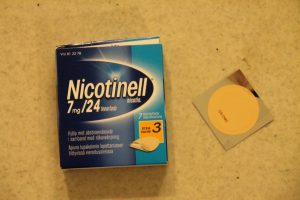
Other Medications Used to Help Stop Smoking
Other prescription medications that might help a person stop smoking and do not contain nicotine are listed below (WebMD, 2023c, 2023f).
- bupropion (Zyban)
- varenicline (Chantix)
Table 5.1. Common Respiratory System Medications
| Generic Name | Trade Name | Reason for Administering |
| albuterol | Ventolin | asthma |
| salmeterol | Serevent | asthma |
| ipratropium | Atrovent | asthma, chronic bronchitis, and emphysema |
| tiotropium | Spiriva | asthma, chronic bronchitis, and emphysema |
| budesonide | Pulmicort | preventing asthma attacks |
| ciclesonide | Alvesco | preventing asthma attacks |
| fluticasone | Flovent | preventing asthma attacks |
| mometasone | Asmanex | preventing asthma attacks |
| theophylline | Elixophyllin | asthma and COPD |
| albuterol/ipratropium | Combivent | COPD |
| fluticasone/salmeterol | Advair | asthma, COPD, bronchitis, and emphysema |
| montelukast | Singulair | allergies, preventing asthma attacks |
| cetirizine | Zyrtec | cold and allergy symptoms |
| diphenhydramine | Benadryl | cold and allergy symptoms |
| fexofenadine | Allegra | cold and allergy symptoms |
| ketotifen | Zaditor | cold and allergy symptoms |
| loratadine | Claritin | cold and allergy symptoms |
| guaifenesin | Mucinex | productive cough |
| dextromethorphan | Robitussin | suppresses cough |
| bupropion | Zyban | smoking cessation |
| nicotine | Nicorette | smoking cessation |
| nicotine inhaler system | Nicotrol | smoking cessation |
| varenicline | Chantix | smoking cessation |
Attribution
Unless otherwise indicated, material on this page has been adapted from the following resource:
Ernstmeyer, K., & Christman, E. (Eds.). (2020). Nursing pharmacology. Chippewa Valley Technical College. https://wtcs.pressbooks.pub/pharmacology/, licensed under CC BY 4.0
References
AbrahamThePharmacist. (2018, February 5). How to use a spacer with an inhaler | How to use spacer device | How to use AeroChamber with Ventolin [Video]. YouTube. https://youtu.be/o0M1lLpOu4U
Cleveland Clinic. (2022). Bronchodilator. https://my.clevelandclinic.org/health/treatments/17575-bronchodilator
SingHealth. (2011, November 24). Asthma care: Step-by-step guide to various inhalers [Video]. YouTube. https://www.youtube.com/watch?v=krHH3vrzaAI
WebMD. (2023a). Advair Diskus blister, with inhalation device – Uses, side effects, and more. https://www.webmd.com/drugs/2/drug-20538/advair-diskus-inhalation/details
WebMD. (2023b). Allergy medications. https://www.webmd.com/allergies/allergy-medications
WebMD. (2023c). Chantix continuing month box 1 mg tablet – Uses, side effects, and more. https://www.webmd.com/drugs/2/drug-158969/chantix-continuing-month-box-oral/details
WebMD. (2023d). Combivent Respimat mist inhaler – Uses, side effects, and more. https://www.webmd.com/drugs/2/drug-161259/combivent-respimat-inhalation/details
WebMD. (2023e). Guaifenesin – Uses, side effects, and more. https://www.webmd.com/drugs/2/drug-3350-118/guaifenesin-oral/guaifenesin-oral/details
WebMD. (2023f). Zyban 150 Mg tablet, extended release – Uses, side effects, and more. https://www.webmd.com/drugs/2/drug-1609/zyban-oral/details
WebMD. (2022). Nicotine addiction treatment. https://www.webmd.com/smoking-cessation/treat-nicotine-addiction
WebMD. (2021). Leukotriene modifiers and allergies. https://www.webmd.com/allergies/leukotriene
Image Credits (images are listed in order of appearance)
Asthma Inhaler (29172634251) by NIAID, CC BY 2.0
Nebulizer Mask (Child) by BruceBlaus, CC BY-SA 4.0
Albuterol 2 by Mark Oniffrey, CC BY-SA 4.0
Treating Kids with Asthma by U.S. Food and Drug Administration, Public domain
Spiriva3 by RonEJ, Public domain
“Spiriva HandiHaler” – brand dry powder inhaler (open) by RonEJ, Public domain
Budesonide and formoterol inhaler by Metrónomo, CC BY-SA 4.0
Fluticasone by James Heilman, MD, CC BY-SA 3.0
Seretide250 by Ebruchez, Public domain
Montelukast Teva 10 mg by Ewave.one, CC BY-SA 4.0
Benadryl tablets (4438315926) by Christopher Holden, CC BY-SA 2.0
Τσίχλες νικοτίνης by Theo0221, CC BY-SA 4.0
NicotinePatch by Styroks, CC BY-SA 4.0
opening or widening of the bronchioles
when the muscles that surround the bronchi tighten
an inhaler that delivers medication by inhalation into the lungs; sometimes called a "puffer"
the action of causing a device to deliver medication, such as pressing the top of the canister or twisting an inhaler to prepare the dose
a device that turns liquid medication into a mist that is inhaled into the lungs using a facemask
a small ampoule of liquid medication that is used with a nebulizer
a plastic device attached to an inhaler that holds the medication while the patient inhales the entire dose
narrowing of the bronchioles
an egg-shaped inhaler device used to deliver medication into the lungs; the medication is inserted into the inhaler in capsule form
an inhaler device that contains a powdered medication that is inhaled into the lungs
narrowing of the bronchioles
a type of inhaler device that contains medication in powder form that is inhaled into the lungs
thickness or consistency
lower part of the brain that controls such functions as heart rate, breathing, and blood pressure


